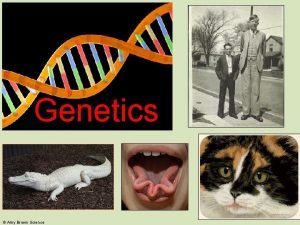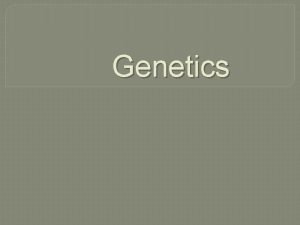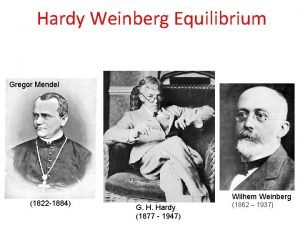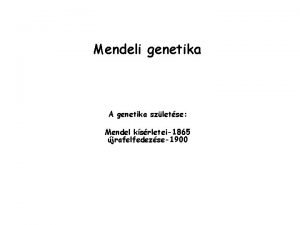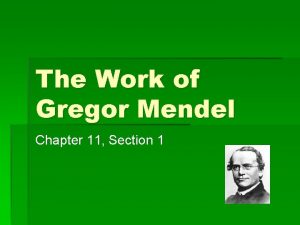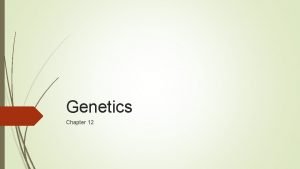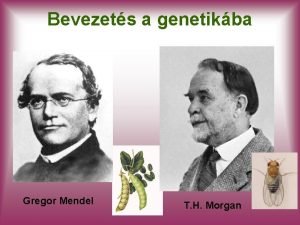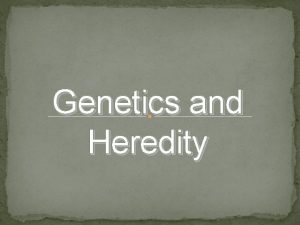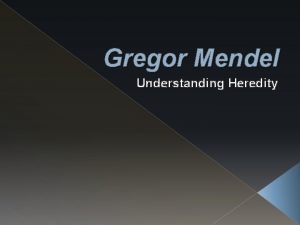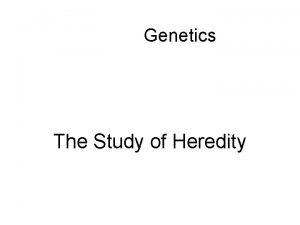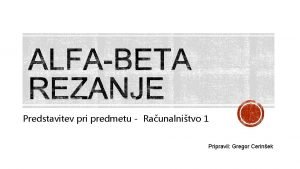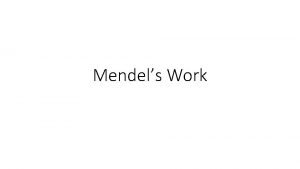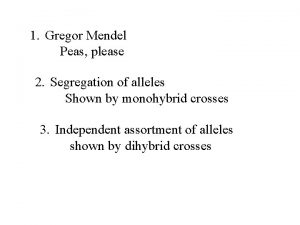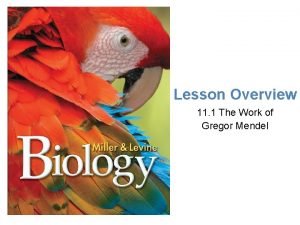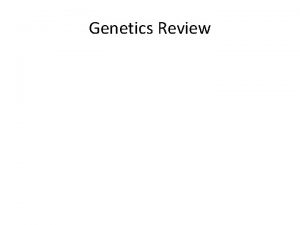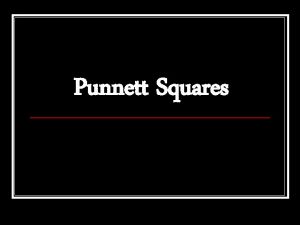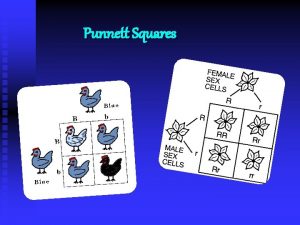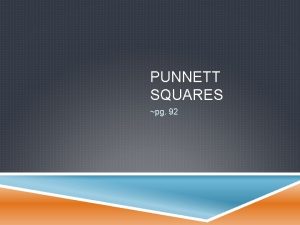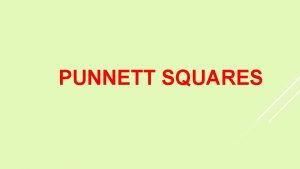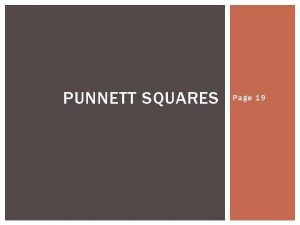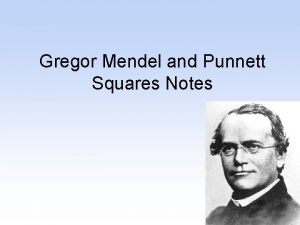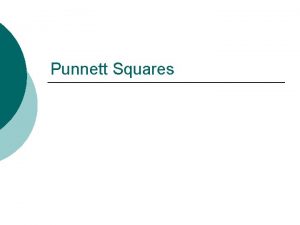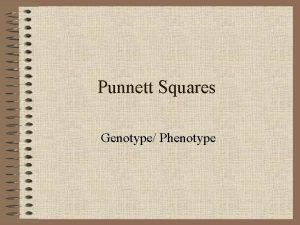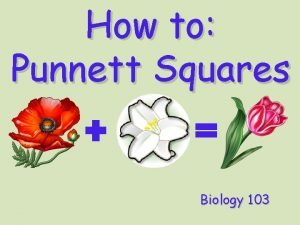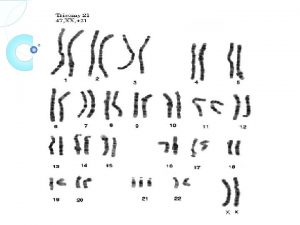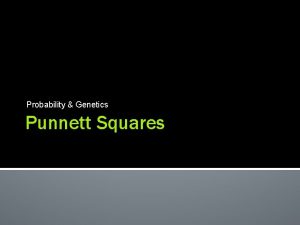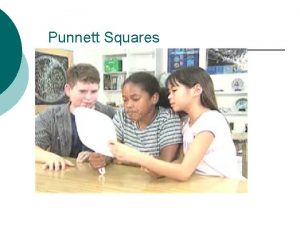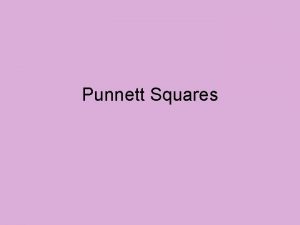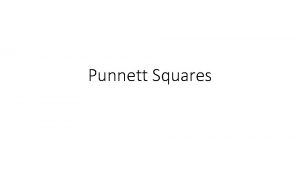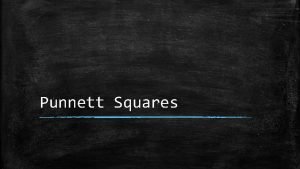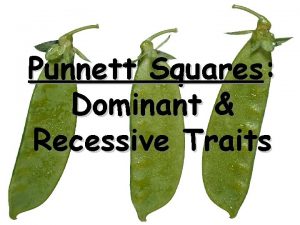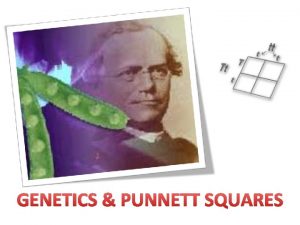Punnett Squares Punnett Square When Gregor Mendel studied





























- Slides: 29

Punnett Squares

Punnett Square • When Gregor Mendel studied pea plants, he noticed patterns in some of the traits. • In some cases, you can predict what traits offspring will have based on the parent’s genetics. • A Punnett Square is a useful tool for predicting traits.

Punnett Square • Punnett square – a graphic used to predict the possible genotypes of offspring in a given cross. • Each parent has two alleles for a particular gene. • An offspring receives one allele from each parent.

Punnett Square 1. To set up a Punnett Square, decide which trait is dominant. 2. dominant trait = capital letter 3. recessive trait = lower case letter 4. One parent’s alleles are placed at the top. 5. The other parent’s alleles are placed along the side.


Results of the Punnett Square • Each individual from the Punnett Square will have a genotype and a phenotype. – genotype – what the genes are (the letters). – phenotype – what the trait looks like.

• homozygous- both alleles are dominant or both are recessive. (so you see either two uppercase or two lower case letters. • heterozygous – each allele is different. (You will see one capital and one lower case).

Punnett Square • Use P for purple flower color • Use p for white flower color homozygous P P homozygous p Pp Pp

Punnett Square • Cross two heterozygous plants heterozygous P p P PP Pp heterozygous p Pp pp

Results of the Punnett Square Punnett Results PP Genotype Phenotype PP Homozygous dominant Purple Flowers Pp Pp Heterozygous Purple Flowers pp pp Homozygous recessive White Flowers


Results of the Punnett Square • The results of a Punnett square will give you the probability of certain outcomes. • Results are usually written as a ratio or a percent.


Complete dominance • complete dominance – the dominant allele hides the recessive. The phenotype will be the dominant characteristic. • You can use a Punnett square and will have two genotypes. RR rr Rr X =

Punnett Square Practice 1. A dog breeder is mating a brown heterozygous lab to a black homozygous lab. Brown is dominant. Set up a Punnett Square and decide what percent of the offspring will be black and brown. X = ?

B = brown b = black One parent is heterozygous brown Bb One parent is homozygous black bb B b b Bb bb

Genotype Phenotype Bb Bb bb brown bb black 50% are brown, 50% are black


Incomplete Dominance • Some traits are not dominant or recessive • incomplete dominance – each allele can affect the phenotype. These traits will blend when heterozygous. • You can use a Punnett square and will have 3 genotypes instead of two RR rr X Rr =

Punnett Square Practice 3. In purple people eaters one eye is homozygous dominant, two eyes is homozygous recessive, and three eyes is heterozygous. The number of eyes in an incomplete dominant trait. What would the offspring look like from a homozygous recessive purple people eater and a homozygous dominant purple people eater? Set up a Punnett Square and find the genotypes and phenotypes of the offspring.

EE = one eye ee = two eyes Ee = three eyes One parent is homozygous dominant One parent is homozygous recessive E E e Ee Ee EE ee

Genotype Phenotype Ee Ee Ee 3 eyes 100% three eyed


Codominance • Some traits are not dominant or recessive • codominance – both of the alleles contribute to the phenotype. The individual will have traits of both phenotypes. • You can use a Punnett square and will have 3 genotypes instead of two. X ==

Punnett Square Practice In snakes, certain colors can be codominant. For our example, we will look at the yellow color in boas. Yellow and White are codominant. What results would you get with a homozygous yellow parent and a homozygous white parent? X = ?

Y = yellow y = white One parent is homozygous yellow One parent is homozygous white Y Y y Yy Yy YY yy

Genotype Phenotype Yy Yy Yy pied 100% are pied


Color in and complete the following chart based on the type of inheritance. Assume parents are homozygous. X complete dominance (blue is dominant to yellow) incomplete dominance codominance
 11-2 probability and punnett squares answer key
11-2 probability and punnett squares answer key Who is the
Who is the Gregor mendel
Gregor mendel What did gregor mendel research
What did gregor mendel research Mendel equilibrium
Mendel equilibrium Gregor mendel munkássága
Gregor mendel munkássága Section 11.1 the work of gregor mendel
Section 11.1 the work of gregor mendel Who is gregor mendel and what did he do?
Who is gregor mendel and what did he do? Chapter 11 biology test
Chapter 11 biology test Chapter 11 the work of gregor mendel
Chapter 11 the work of gregor mendel Chapter 12 lesson 1 the work of gregor mendel
Chapter 12 lesson 1 the work of gregor mendel Fr gregor mendel
Fr gregor mendel Mendel traits
Mendel traits Gregor mendel chart
Gregor mendel chart Johann sebastian bach geboren
Johann sebastian bach geboren Gregor johann mendel
Gregor johann mendel What did gregor mendel research
What did gregor mendel research Mendel
Mendel Gregor mendel referat
Gregor mendel referat Who was gregor mendel
Who was gregor mendel Who was mendal
Who was mendal Gregor mendel mbti
Gregor mendel mbti Blood types
Blood types Gregor mendel laws
Gregor mendel laws Chapter 12 lesson 1 the work of gregor mendel
Chapter 12 lesson 1 the work of gregor mendel Gregor mendel 1865
Gregor mendel 1865 Law of segregation meiosis
Law of segregation meiosis Gregor mendel
Gregor mendel How many pairs of chromosomes do humans have? *
How many pairs of chromosomes do humans have? * Gregor mendel
Gregor mendel

